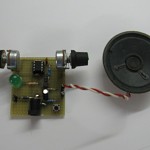The Atari Punk Console (APC) is a popular circuit made using two 555 timer ICs. The original circuit, called a “Stepped Tone Generator“, was realized by Forrest M. Mims III and first published in 1980 in a Radio Shack booklet entitled “Engineer’s Notebook: Integrated Circuit Applications”. It was named “Atari Punk Console” by Kaustic Machines because its noise resembled the sounds of classic Atari console games from the 80s, with a square wave output very similar to those of the Atari 2600.
This implementation is done using an ATtiny85 microcontroller, but you can use an ATtiny25 too,because the firmware is only 820 bytes in size. It should be adaptable to other Atmel MCUs, just look for proper register names into the datasheet of the microcontroller you want to use.
The circuit uses 2 potenziometers to adjust the frequency and the period of the sound. The frequency is set using an internal timer while the period is set modifying the delay used to increment/decrement the counter of the timer (pulsing effect of the sound). An LED shows what signal is coming to the speaker. The button is used to scroll the prescaler between 3 differents values so that the noise has 3 different frequency ranges.
The circuit can be powered directly to the jack with a regulated 5V voltage (at least 500 mA of current is needed) or by 4 AAA NiMH rechargeble batteries (the Schottky diode prevents polarity inversions and decrease the voltage input: 4 rechargeble batteris at full charge could provide up to 1.4*4=5.6V so that the input voltage can drop of 0.2/0.3V and stays under 5.5V that is the maximum allowed voltage for the MCU).
The circuit is very simple and uses only through-hole components so that anyone can replicate it. I realized it on a protoboard. The potenziometers have a value of 100Kohm and are linear taper potenziometers. The speaker is a common 8 ohm/0.5W speaker: mine is more than 30 years old and it’s still working greatly
The sketch has been written with Arduino IDE 1.0.5 and compiled using the Atmel toolchain 3.4.2 but it should compile with the toolchain included into the Arduino IDE. To compile the sketch you also need the Tiny core: at the time of this document the most recent version of the core is the 0100-0017.
All the files of this project (picture, schematic and Eagle files) are released under the therms of the Creative Commons Attribution-Share Alike-Not Commercial (BY-SA-NC) 3.0. The sketch is free software; you can redistribute it and/or modify it under the terms of the GNU General Public License as published by the Free Software Foundation; either version 3.0 of the License, or (at your option) any later version.





